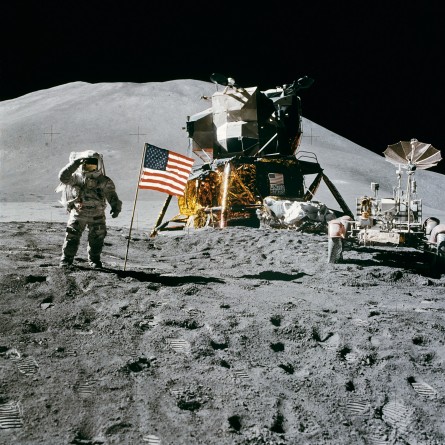
Forty-one years ago today, Apollo 15 landed in the Hadley-Appennine region of the Moon. The fourth manned lunar landing, Apollo 15 was one of the most scientifically successful and geologically diverse of the Apollo Lunar Landing Program.
Apollo 15 lifted-off from LC-39A at Cape Canaveral, Florida at 13:34 UTC on Monday, 26 July 1971. The all-Air Force flight crew consisted of Commander David R. Scott, Command Module Pilot Alfred M. Worden and Lunar Module Pilot James B. Irwin. While Apollo 15 was Scott’s third spaceflight, Irwin and Worden were space rookies.
Apollo 15 was the first of the Apollo “J” missions wherein lunar surface stay duration was extended to three (3) days. This was sufficient time for lunar explorers to conduct a trio of Lunar Extravehicular Activity (LEVA) periods. Each LEVA was approximately 6 to 7 hours in length. The Lunar Module (LM) was provisioned with extra equipment and consumables to support these extended stay operations.
Another “J” mission feature was the use of the Lunar Rover (LR). This electric-powered marvel conveyed astronauts over the lunar surface at speeds up to 8 mph. It’s range from the LM was limited by a “Walkback Limit” of about 5 miles. That is, should the LR fail at any point during a lunar excursion, the astronauts had to have sufficient oxygen remaining to permit them to walk back to the LM a distance of up to 5 miles.
The Apollo 15 Lunar Module Falcon, with Dave Scott and Jim Irwin onboard, landed at 22:16:29 UTC in the Hadley-Appennine region of the Moon on Friday, 30 July 1971. High overhead, Al Worden orbited the Moon alone in the Command Module (CM) Endeavor.
Scott and Irwin conducted 3 separate LEVA’s totaling slightly over 18.5 hours. During these lunar jaunts, they collected 170 lbs of lunar samples. Their biggest find was the so-called “Genesis Rock” estimated to be 4.1 billion years old. As per previous Apollo lunar landing missions, the Apollo 15 astronauts deployed an Apollo Lunar Surface Experiments Package (ALSEP) which permitted monitoring of the lunar environment long after the crew’s return to Earth.
A unique aspect of Apollo 15 was Commander Scott’s conduct of a simple experiment on the lunar surface. With a geology hammer in his right hand and a Falcon feather in his left, the astronaut released both objects simultaneously. Television viewers back on Earth witnessed both items striking the ground at the same moment. This result confirmed Galileo’s assertion that all objects in a vacuum fall at the same rate independent of their mass.
The Apollo 15 lunar explorers’ stay on the Moon lasted almost 67 hours. Falcon lifted-off from the Moon at 17:11:23 UTC on Monday, 02 August 1971. For the first time, lift-off of the LM ascent stage was televised back to Earth via a TV camera attached to the LR. Slightly less than 2 hours later, Scott and Irwin successfully rendezvoused and docked with Worden.
The crew of Apollo 15 started the trip back to Earth at 21:22:45 UTC on Wednesday, 04 August 1971 with a successful Transearth Injection burn of their Service Propulsion System (SPS). Just before leaving lunar orbit, the astronauts deployed a subsatellite designed to conduct a long duration study the lunar plasma, particle, magnetic and gravitational environments. The next day, Al Worden successfully completed a 39-minute EVA in deep space as he retrieved exposed film from cameras located in a special bay within the Service Module (SM).
Endeavor and her crew successfully reentered the Earth’s atmosphere on Saturday, 07 August 1971. During descent, one of the CM’s three (3) main parachutes failed to deploy properly and caused the CM splashdown sink rate to be higher than normal. However, the robust crew survived the subsequent hard landing in the North Pacific Ocean without apparent ill effect. Crew and craft were safely recovered aboard the USS Okinawa.
Mission elapsed time for Apollo 15 was 295 hours, 11 minutes and 53 seconds. The maturation of lunar surface operations that made an extended stay possible and provided for enhanced exploration activities wrought a substantial scientific bounty. Indeed, the knowledge and experience gained during the Apollo 15 mission went a long way to helping the Apollo Program make the most of history’s last pair of manned lunar landing missions; Apollo 16 and Apollo 17.
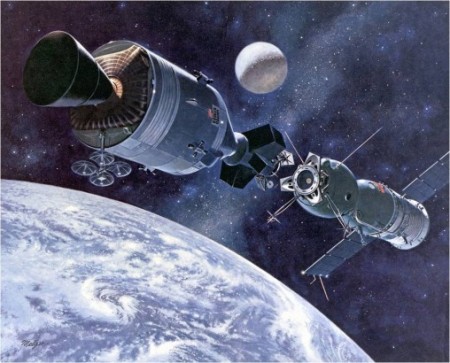
Thirty-seven years ago this month, the first joint United States-Soviet Union spaceflight was successfully conducted. This historic event also marked the first time that spacecraft from two nations successfully rendezvoused and docked in orbit.
The Apollo-Soyuz Test Project (ASTP) was the first international manned spaceflight. The primary objectives of ASTP were to (1) test the compatibility of rendezvous and docking systems of American and Soviet spacecraft, (2) pave the way for international space rescue and (3) set the stage for future joint manned spaceflights.
The United States flew an Apollo Command-Service Module (CSM) with three men on board; Commander Thomas P. Stafford, Vance D. Brand and Donald K. “Deke” Slayton. This was Stafford’s 4th time in space while Brand and Slayton were space rookies. Slayton, one of the original Mercury Seven, had been deprived of a Mercury flight due to what flight surgeons claimed was a heart murmur. ASTP was Slayton’s ultimate vindication from what he always considered to be a specious medical issue.
The Soviet Union flew a Soyuz spacecraft as part of ASTP. It was the 19th such vehicle flown by the Soviets. On board were Cosmonauts Aleksey A. Leonov and Valery N. Kubasov. ASTP was the second spaceflight for both men. Leonov held the distinction of being the first human to perform a spacewalk. That achievement occurred in March of 1965 during the flight of Voskhod 2.
The Apollo CSM carried a special docking module that permitted the spacecraft to dock with the Soyuz. It also functioned as an airlock since the two vehicles employed different pressurization systems. Apollo used pure oxygen pressurized to 5.0 while Soyuz utilized a nitrogen-oxygen atmosphere pressurized at 10.0 psia. Once the Apollo and Soyuz were docked, the docking module also served as conduit between the two spacecraft through which men and cargo could pass.
The ASTP mission began with launch of the Soyuz spacecraft from Baikonur Cosmodrome on Tuesday, 15 July 1975. Seven and a half hours later, the Apollo spacecraft was launched from LC-39B at Cape Canaveral, Florida. On Thursday, 17 July 1975, 52 hours after the mission began, the two spacecraft successfull docked in space. This event marked the first time in spaceflight history that such a feat had been accomplished.
Over the next 48 hours, the crews participated in a variety of activities and exercises. Crew members from each country were able to transfer to the spacecraft of the other via a tunnel in the docking module. Ceremonies were held onboard to mark the occasion. Several dockings and undockings between the two spacecraft were accomplished as well. A variety of space experiments rounded out the schedule.
On Saturday, 19 July 1975, Apollo and Soyuz undocked for the final time. The two spacecraft subsequently maneuvered to achieve widely separated orbits. Following additional time on-orbit in which a variety of space experiments were conducted, each spacecraft returned to Earth. Soyuz did so on Monday, 21 July 1975. Apollo followed on Wednesday, 24 July 1975.
ASTP was the last spaceflight conducted by the United States using an Apollo spacecraft. It also marked the end of America’s initial manned spaceflight effort that began in 1961 with Project Mercury. ASTP was also the country’s last manned spaceflight of the 1970’s. Indeed, not until the first flight of the Space Shuttle in April of 1981 that America would once again fly men into space.
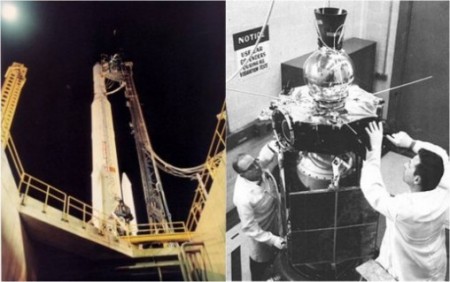
Forty-five years ago this week, the Explorer 35 satellite was launched on a mission to investigate the space environment in the vicinity of the Moon. Among other discoveries, the 230-lb satellite would find that the Moon does not have a magnetosphere like Earth.
Explorer is the longest running satellite program in the history of American spaceflight. Indeed, the first satellite orbited by the United States was Explorer I in January of 1958. Since that time, a total of ninety (90) Explorer satellites have been launched into space for the purpose of investigating the space environments of the Earth, Moon and Sun.
Explorer 35, also known as Anchored Interplanetary Monitoring Platform 6 (AIMP-6), was designed to expand our knowledge concerning a variety of interplanetary space phenomena. The characteristics of the solar wind, interplanetary magnetic field, lunar gravitational field and lunar radiation environment were of particular focus.
Explorer 35 carried an array of scientific instruments to probe the lunar space environment. Key spacecraft instrumentation included multiple magnetometers, geiger tubes, and ion chambers. The spacecraft instrument package also included thermal ion and micrometeoroid detectors as well as a Faraday cup.
On Wednesday, 19 July 1967, Explorer 35 was launched towards the Moon by a Thor-Delta launch vehicle; the 50th such vehicle flown. Lift-off from LC-17B at Cape Canaveral, Florida occurred at 14:19:02 UTC. Flying a direct ascent trajectory, the spacecraft arrived in lunar orbit on Friday, 21 July 1967.
Explorer 35’s orbit about the Moon was highly-elliptical; featuring an apolune of 4,152 nm and a perilune of 432 nm. During its operational lifetime, the satellite found that the Moon has no magnetosphere, that the solar wind impacts the lunar surface directly and that a void in the solar wind exists in the lee of the Moon.
Explorer 35 provided a wealth of scientific data that greatly expanded our knowledge of the Moon and its space environment. After continuously probing that environment for nearly six (6) years, Explorer 35 was permanently turned-off via command from Earth on Sunday, 24 June 1973. While the craft has long since fallen from lunar orbit, the exact time and location of impact are not known.
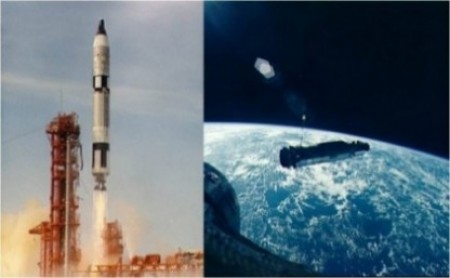
Forty-six years ago this month, NASA Astronauts John W. Young and Michael Collins completed the highly successful mission of Gemini 10. Among other accomplishments, the Gemini 10 crew established a new manned spaceflight record when they rode their Gemini-Agena spacecraft to an altitude of 412 nm above the Earth.
The Gemini Program consisted of ten manned spaceflights flown in a twenty month period starting in March of 1965. Gemini pioneered key technologies required to land men on the Moon including space navigation, rendezvous, docking, orbital maneuvering, long-duration spaceflight and extra-vehicular activity (EVA). Without Gemini, the United States would not have achieved the goal of landing men on the Moon before the end of the 1960’s.
Gemini-Titan 10 (GT-10) was launched from LC-19 at Cape Canaveral, Florida on Monday, 18 July 1966. Lift-off time was 22:20:26 UTC. Roughly 100 minutes earlier, an Agena Target Vehicle (ATV) had been launched from LC-14 into a 162 nm circular parking orbit. Gemini 10 successfully rendezvoused and docked with the ATV at 04:15:00 UTC on Tuesday, 19 July 1966.
Using the Agena’s restartable rocket motor, the docked Gemini-Agena combination was boosted into a 412 nm x 159 nm elliptical orbit. This trajectory exposed the astronauts to flight through portions of the Earth’s radiation belts. Dosimeter measurements revealed that radiation levels at apogee did not constitute a significant health issue for the astronauts. While docked with the Agena, Collins conducted a 49-minute stand up EVA starting at 21:44:00 UTC on 19 July.
After several more burns of the Agena rocket motor, the astronauts undocked from the ATV at 19:00:00 UTC on Wednesday, 20 July 1966. These Agena-aided maneuvers placed Gemini 10 in a position to later use its own orbital maneuver system to complete a rendezvous with the Gemini 8 Agena Target Vehicle at an orbital altitude of 204 nm. This event marked the first time in spaceflight history that a spacecraft successfully rendezvoused with two separate vehicles on the same mission.
At 23:01:00 UTC on 20 July, Collins started a 39-minute EVA in which he floated over to examine the Gemini 8 ATV. He had difficulty trying to hold on to the vehicle, but was able to retrieve a micrometeorite collector for analysis back on Earth. Collins also used a hand-held maneuvering unit powered by nitrogen gas. This effort was short-lived as he quickly ran out of the gaseous propellant. Finally, Collins reentered the Gemini 10 and with some effort was able to secure his hatch.
After 43 orbits, Gemini 10 reentered the Earth’s atmosphere on Thursday, 21 July 1966. The spacecraft landed at 21:07:05 UTC in the Atlantic Ocean, only 3 nm off target. Crew and spacecraft were recovered by the USS Guadalcanal.
Though highly successful, Gemini 10, like all Gemini missions, had its share of problems. But, just like all other Gemini missions, it was in the overcoming of its problems that Gemini 10 moved the United States materially closer to the realization of the nation’s lunar landing goal. While trying times lay ahead for the United States space effort, including a national tragedy, that lofty goal would be realized in the summer of 1969.
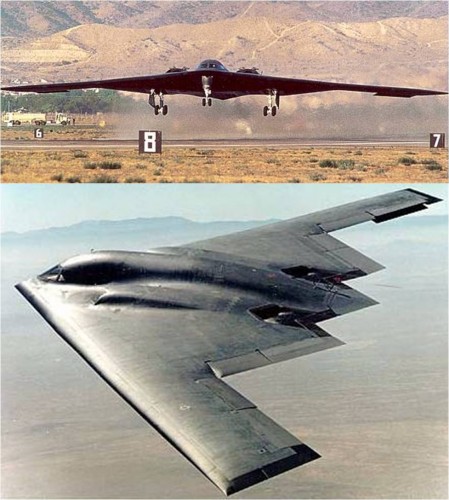
Twenty-three years ago this month, the USAF/Northrop B-2 Stealth Strategic Bomber flew for the first time. The aircrew for the B-2’s maiden trip upstairs included Northrop B-2 Division Chief Test Pilot Bruce J. Hinds (command pilot) and B-2 Combined Test Force Commander USAF Col. Richard S. Couch (co-pilot).
The B-2 traces it lineage to a variety of Northrop flying wing aircraft including the piston-powered YB-35 and jet-propelled YB-49. These 1940’s-era experimental aircraft served as important stepping stones in the evolution of large flying wing technology.
An all-wing aircraft represents an aerodynamically-optimal configuration from the standpoint of high lift, low drag and therefore high lift-to-drag ratio. These favorable aerodynamic attributes translate to high levels of range performance and load-carrying capability. In addition, the type’s high aspect ratio and slim profile provide for more favorable low observable characteristics than traditional fuselage-wing-empennage aircraft geometries.
Arguably the most challenging aspects of creating an all-wing aircraft have to do with flight control and handling qualities. The crash of the second YB-49 flying wing in June of 1948 underscored the insufficiency of aerospace technology at that time to handle these design challenges. It was not until the advent of modern flight control avionics during the 1980’s that the full potential of a flying wing aircraft would be realized.
The B-2 is only 69 feet in length, but has a wing span of 172 feet and a wing area of 5,140 square feet. Gross take-off and empty weights are 336,500 lbs and 158,000 lbs, respectively. Embedded within the wings are a quartet of fuel-efficient F118-GE-100 turbofan engines, each generating 17,300 lbs of thrust. The aircraft has a top speed of about Mach 0.85, an unrefueled range of 6,000 nm and a service ceiling of 50,000 feet. Maximum ordnance load is 50,000 lbs.
B-2 AV-1 (Spirit of America; S/N 82-1066) took-off for the first time from Air Force Plant 42 in Palmdale, California on Monday, 17 July 1989. Supported by F-16 chase aircraft, the majestic flying wing flew a 2 hour 12 minute test mission which concluded with a landing at nearby Edwards Air Force Base. As a first flight precaution, the entire mission was flown with the landing gear down.
The first B-2 airframe to enter the operational inventory was AV-8, the Spirit of Missouri (S/N 88-0329). It did so on 31 March 1994. While initial plans called for a production run of 132 aircraft, only 21 B-2 airframes were actually built. With the 2008 loss of the Spirit of Kansas shortly after take-off from Andersen Air Force Bas in Guam, 20 of these aircraft remain in active service today.
Whiteman Air Force Base in Missouri serves as Air Force’s home for the B-2. From there, the majestic flying wing has flown a multitude of global strike missions to deliver a variety of ordnance with pinpoint accuracy. To date, the B-2 has successfully engaged targets in Kosovo, Afganistan, Iraq and Libya. The B-2 is truly a technological marvel and a national defense asset. As such, it may be expected to be a vital part of the Air Force’s active inventory for decades to come.






